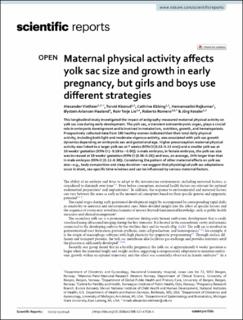| dc.contributor.author | Vietheer, Alexander | |
| dc.contributor.author | Kiserud, Torvid | |
| dc.contributor.author | Ebbing, Cathrine | |
| dc.contributor.author | Rajkumar, Hemamaalini | |
| dc.contributor.author | Haaland, Øystein Ariansen | |
| dc.contributor.author | Lie, Rolv T. | |
| dc.contributor.author | Romero, Roberto | |
| dc.contributor.author | Kessler, Jørg | |
| dc.date.accessioned | 2024-04-24T12:50:16Z | |
| dc.date.available | 2024-04-24T12:50:16Z | |
| dc.date.created | 2023-12-05T09:00:10Z | |
| dc.date.issued | 2023 | |
| dc.identifier.issn | 2045-2322 | |
| dc.identifier.uri | https://hdl.handle.net/11250/3127956 | |
| dc.description.abstract | This longitudinal study investigated the impact of actigraphy-measured maternal physical activity on yolk sac size during early development. The yolk sac, a transient extraembryonic organ, plays a crucial role in embryonic development and is involved in metabolism, nutrition, growth, and hematopoiesis. Prospectively collected data from 190 healthy women indicated that their total daily physical activity, including both light and moderate-vigorous activity, was associated with yolk sac growth dynamics depending on embryonic sex and gestational age. Higher preconception maternal physical activity was linked to a larger yolk sac at 7 weeks (95% CI [0.02–0.13 mm]) and a smaller yolk sac at 10 weeks’ gestation (95% CI [− 0.18 to − 0.00]) in male embryos; in female embryos, the yolk sac size was increased at 10 weeks’ gestation (95% CI [0.06–0.26]) and was, on average, 24% larger than that in male embryos (95% CI [0.12–0.38]). Considering the pattern of other maternal effects on yolk sac size—e.g., body composition and sleep duration—we suggest that physiological yolk sac adaptations occur in short, sex-specific time windows and can be influenced by various maternal factors. | en_US |
| dc.language.iso | eng | en_US |
| dc.publisher | Springer Nature | en_US |
| dc.rights | Navngivelse 4.0 Internasjonal | * |
| dc.rights.uri | http://creativecommons.org/licenses/by/4.0/deed.no | * |
| dc.title | Maternal physical activity affects yolk sac size and growth in early pregnancy, but girls and boys use different strategies | en_US |
| dc.type | Journal article | en_US |
| dc.type | Peer reviewed | en_US |
| dc.description.version | publishedVersion | en_US |
| dc.rights.holder | Copyright 2023 the authors | en_US |
| dc.source.articlenumber | 20246 | en_US |
| cristin.ispublished | true | |
| cristin.fulltext | original | |
| cristin.qualitycode | 1 | |
| dc.identifier.doi | 10.1038/s41598-023-47536-4 | |
| dc.identifier.cristin | 2208894 | |
| dc.source.journal | Scientific Reports | en_US |
| dc.identifier.citation | Scientific Reports. 2023, 13, 20246. | en_US |
| dc.source.volume | 13 | en_US |

